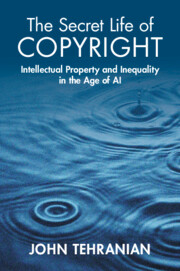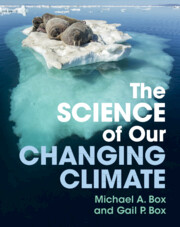Refine search
Actions for selected content:
107 results
4 - Dialogue
-
- Book:
- The Prompts You Need to Help You Write the Book You Want to Write
- Published online:
- 25 October 2025
- Print publication:
- 06 November 2025, pp 47-63
-
- Chapter
- Export citation
Chapter 6 - Social Cognition and Conversation Memory
-
- Book:
- Conversation Memory
- Published online:
- 09 October 2025
- Print publication:
- 23 October 2025, pp 79-92
-
- Chapter
- Export citation
Positive reciprocity when motives are ambiguous
-
- Journal:
- Experimental Economics ,
- Published online by Cambridge University Press:
- 14 August 2025, pp. 1-24
-
- Article
-
- You have access
- Open access
- HTML
- Export citation

The Secret Life of Copyright
- Intellectual Property and Inequality in the Age of AI
-
- Published online:
- 08 August 2025
- Print publication:
- 14 August 2025
16 - Reflections on the Interface between Word-Formation and Syntax
- from Part IV - Interfaces
-
- Book:
- Reflections on English Word-Formation
- Published online:
- 03 October 2025
- Print publication:
- 07 August 2025, pp 131-137
-
- Chapter
- Export citation
Chapter 8 - State responsibility
-
- Book:
- International Law
- Published online:
- 26 July 2025
- Print publication:
- 31 July 2025, pp 413-476
-
- Chapter
- Export citation
17 - Climate Causality
- from Part IV - Liability and Evidence
-
-
- Book:
- The Cambridge Handbook on Climate Litigation
- Published online:
- 03 June 2025
- Print publication:
- 31 July 2025, pp 415-444
-
- Chapter
-
- You have access
- Open access
- HTML
- Export citation
12 - The Law of State Responsibility: A Period of Great Advances
-
-
- Book:
- The Cambridge History of International Law
- Published online:
- 01 May 2025
- Print publication:
- 29 May 2025, pp 362-389
-
- Chapter
- Export citation
18 - How, and Why, is Our Climate Changing?
- from Part V - Our Changing Climate
-
- Book:
- The Science of Our Changing Climate
- Published online:
- 05 April 2024
- Print publication:
- 02 May 2024, pp 308-333
-
- Chapter
- Export citation
Can you have it both ways? Attribution and plausible deniability in unclaimed coercion
-
- Journal:
- European Journal of International Security / Volume 9 / Issue 4 / November 2024
- Published online by Cambridge University Press:
- 08 April 2024, pp. 493-510
-
- Article
- Export citation

The Science of Our Changing Climate
-
- Published online:
- 05 April 2024
- Print publication:
- 02 May 2024
-
- Textbook
- Export citation
5 - The Enduring Charter
- from Part I - International Attribution
-
-
- Book:
- States, Firms, and Their Legal Fictions
- Published online:
- 29 February 2024
- Print publication:
- 07 March 2024, pp 87-110
-
- Chapter
- Export citation
4 - Contractors and Hybrid Warfare
- from Part I - International Attribution
-
-
- Book:
- States, Firms, and Their Legal Fictions
- Published online:
- 29 February 2024
- Print publication:
- 07 March 2024, pp 69-86
-
- Chapter
- Export citation
3 - Between States and Firms
- from Part I - International Attribution
-
-
- Book:
- States, Firms, and Their Legal Fictions
- Published online:
- 29 February 2024
- Print publication:
- 07 March 2024, pp 47-68
-
- Chapter
- Export citation
1 - Introduction
-
-
- Book:
- States, Firms, and Their Legal Fictions
- Published online:
- 29 February 2024
- Print publication:
- 07 March 2024, pp 1-22
-
- Chapter
- Export citation
6 - Corporate Structures and the Attribution Dilemma in Multinational Enterprises
- from Part II - Transnational Attribution
-
-
- Book:
- States, Firms, and Their Legal Fictions
- Published online:
- 29 February 2024
- Print publication:
- 07 March 2024, pp 113-130
-
- Chapter
- Export citation
2 - Attribution in International Law
- from Part I - International Attribution
-
-
- Book:
- States, Firms, and Their Legal Fictions
- Published online:
- 29 February 2024
- Print publication:
- 07 March 2024, pp 25-46
-
- Chapter
- Export citation
4 - Conjunctions
-
- Book:
- Set-Theoretic Multi-Method Research
- Published online:
- 22 February 2024
- Print publication:
- 29 February 2024, pp 91-139
-
- Chapter
- Export citation
15 - Fact-Finding and Cyber Attribution
- from Part III - New Opportunities and the Future of International Dispute Settlement
-
-
- Book:
- The Changing Character of International Dispute Settlement
- Published online:
- 14 December 2023
- Print publication:
- 21 December 2023, pp 439-466
-
- Chapter
- Export citation
5 - Responding to Public and Private Cyberattacks
-
-
- Book:
- Public and Private Governance of Cybersecurity
- Published online:
- 09 November 2023
- Print publication:
- 23 November 2023, pp 103-133
-
- Chapter
- Export citation
